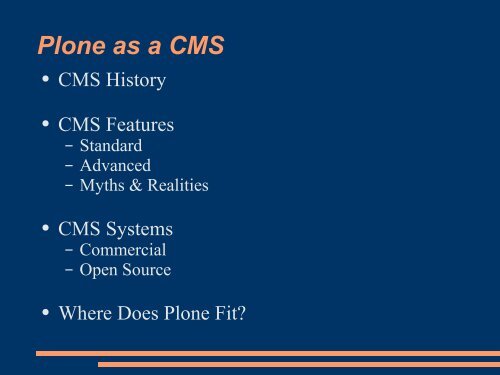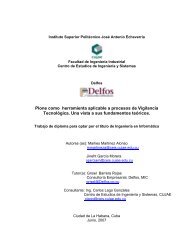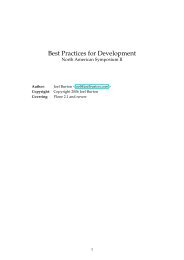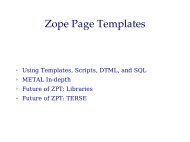An Outside Perspective of Plone
An Outside Perspective of Plone
An Outside Perspective of Plone
You also want an ePaper? Increase the reach of your titles
YUMPU automatically turns print PDFs into web optimized ePapers that Google loves.
<strong>Plone</strong> as a CMS●CMS History●CMS Features– Standard– Advanced– Myths & Realities●CMS Systems– Commercial– Open Source●Where Does <strong>Plone</strong> Fit?
<strong>Plone</strong> as a CMS●CMS Features (Standard)– Some form <strong>of</strong> secure editing– Versioning and rollback– WYSIWYG Editing– Content Entry Templates– Some form <strong>of</strong> workflow– Separation <strong>of</strong> content and meta data
<strong>Plone</strong> as a CMS●CMS Features (Advanced)– Support for dev / stage / production environments– Spell checking– Some type <strong>of</strong> system API– Separation <strong>of</strong> content management and content display– Publish to one or more display servers●●●TransactionallyMeta data database on presentation serversPublish over Internet (SSL / SSH)– Multi site capability
<strong>Plone</strong> as a CMS●What people are asking for– In context editing (Blog or Wiki style)– Taxonomy management– Navigation management integrated with toolsets
<strong>Plone</strong> as a CMS● CMS Myth #1– Enables distributed authorship– Build it and they will come– Web masters will never have to touch content again●Reality– Not always...– Many implementations are still managed by webmasters
<strong>Plone</strong> as a CMS● CMS Myth #2– Complex, custom workflows are great●Reality– Standard out <strong>of</strong> the box workflows are usuallysufficient– Back-door, rapid promote mechanisms are used moreand more– Self-promote mechanisms are used more and more
<strong>Plone</strong> as a CMS● CMS Myth #3– Consistency <strong>of</strong> content through templates●Reality– Proper templates are usually built during intialbuildout.– Need for more flexibility leads to a “Generic HTML”template– Generic HTML template then becomes primarytemplate for the site
<strong>Plone</strong> as a CMS●Commercial Vendors (The Big Three)– Vignette– Documentum– Interwoven
<strong>Plone</strong> as a CMS●Vignette– Technology●●●Legacy sytem is TCL based, current is Java J2EEDatabase and File System based backing storeMulti site capable– Separation <strong>of</strong> management and display●●●●Display is former Epicentric PortalCan be used with custom UIContent receiver agents on display serversPublish over Internet– Content Transformation●●No real transformationFinal rendering is programmatic through JSP
<strong>Plone</strong> as a CMS●Documentum (Web Publisher)– Technology●●●●Built on Content Server (Object-Relational DB)User interfaces are Java J2EE basedDatabase and File System based backing storeMulti site capable– Separation <strong>of</strong> Management and Display●●●●Display agnostic - static, portal or custom displayContent receiver agents on display serversPublish over InternetLarge scale replication to cluster or farm– Content Transformation●●Extended XSL to drive multi-format outputMany rendering engines (e.g. PDF, Office, etc.)
<strong>Plone</strong> as a CMS●Interwoven– Technology●●Perl based, some Java J2EEFile system data store – no database– Separation <strong>of</strong> Management and Display●●●●Display agnostic or use <strong>of</strong> Interwoven web frameworkNo receiver agents – file system publish onlyNo publish over InternetAttributes published as XML manifest– Content Transformation●Standard XSL style transformation
<strong>Plone</strong> as a CMS●Open Source– Examples●●●Open CMS (Java)Mambo (PHP)<strong>Plone</strong> (Zope / Python)– In General●●●●●●Spotty implementation <strong>of</strong> standard featuresNo separation <strong>of</strong> management & displayDisplay hard to modify without knowing underlyinglanguage and architectureSome workflowNo notion <strong>of</strong> dev / staging / productionMinimal to no support <strong>of</strong> clusters or server farms
<strong>Plone</strong> as a CMS●Why is <strong>Plone</strong> Different?– Matches most open source systems for standardfeatures– Provide advanced features <strong>of</strong> commercial systems●●●●Separation <strong>of</strong> display and managementTransactional publishing over the InternetMulti-site supportPresentation layer flexibility– Has some very cool unique features●●Cut & pasteStandards basis (XML-RPC, WebDAV, RDF)
<strong>Plone</strong> as a CMS●Where does <strong>Plone</strong> fit?– Small to medium websites (< 500 pages or so)●Corporate websites, Not for pr<strong>of</strong>it, Educational– Publishing oriented websites●Newspapers, journals, etc.– Intranets●Corporate, Departmental, Focused, etc.– Commerce●Real estate, Retail, Travel, etc.
<strong>Plone</strong> as a CMS●What will <strong>Plone</strong> need?– Support– Implementation services– Upgrade cycles need to be relatively painless●●Backwards compatibilityMigration paths and tools– Development tools●User friendly IDEs for template creation








